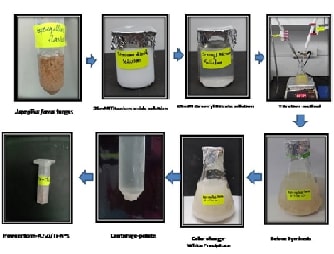Aspergillus flavus Mediated Extracellular One-pot Synthesis of Zirconium and Titanium Oxide Nanoparticles and their Antioxidant and Anti-inflammatory Efficacy Study

Abstract:
The present study reports the extracellular one-pot
synthesis of zirconium and titanium oxide nanoparticles (Zr/TiO-NPs) mediated
by Aspergillus flavus. This green synthesis approach leverages the
bio-reductive capabilities of fungal metabolites, providing an environmentally friendly
and efficient method for nanoparticle synthesis . The synthesized nanoparticles were
evaluated for their antioxidant and anti-inflammatory activities. Antioxidant
activity, assessed at varying concentrations (20–80 µg/ml), demonstrated a
concentration-dependent manner , with the highest activity observed at 80
µg/ml. Similarly, the anti-inflammatory efficacy, determined using the albumin
denaturation method, revealed maximum activity at 100 µg/ml and the lowest at
20 µg/ml, highlighting their potential to mitigate inflammatory responses.
These findings underscore the potential of Aspergillus flavus Zr/TiO-NPs as
promising agents for biomedical applications, particularly in combating
oxidative stress and inflammation.
References:
[1]. Krishnaswamy,
K., Orsat, V., 2017, Sustainable delivery systems through green nanotechnology.
In Nano-and microscale drug delivery systems Elsevier. (PP 17-32). https://doi.org/10.1016/B978-0-323-52727-9.00002-9
[2]. Karthiga,
P., Ponnanikajamideen, M., Samuel Rajendran, R., Annadurai, G., Rajeshkumar, S.,
2019, Characterization and toxicology evaluation of zirconium oxide
nanoparticles on the embryonic development of zebrafish, Daniorerio. Drug &
Chemical Toxicology, 42(1).https://doi.org/10.1080/01480545.2018.1523186
[3]. Aleem, A. R., Shahzadi,
L., Nasir, M., Hajivand, P., Alvi, F., Akhtar, A., Yar, M., 2022, Developing
sulfur‐doped titanium oxide nanoparticles loaded chitosan/cellulose‐based
proangiogenic dressings for chronic ulcer and burn wounds healing. Journal of Biomedical Materials Research
Part B: Applied Biomaterials, 110(5),
1069-1081.https://doi.org/10.1002/jbm.b.34981
[4]. Fouda, A., Awad, M. A.,
Al-Faifi, Z. E., Gad, M. E., Al-Khalaf, A. A., Yahya, R., Hamza, M. F., 2022,
Aspergillus flavus-mediated green synthesis of silver nanoparticles and
evaluation of their antibacterial, anti-candida, acaricides, and photocatalytic
activities. Catalysts, 12(5), 462. https://doi.org/10.3390/catal12050462
[5]. Shravani, V. P.,
Sundari, S. K., Jeyachandran, S., Nagesh, S., 2023, Green synthesis and
characterization of Xanthium strumarium-mediated titanium dioxide
nanoparticles. Cureus, 15(12). https://doi.org/10.7759/cureus.51012.
[6]. Veerabhadraswamy, B. N.,
Pradeep, H. K., Swaroop, K., Manoj, K. M., Nadigar, M. D., Patel, M. A.,
Bhagya, N. P., 2024, Green synthesis and characterization of Zirconium Oxide
with antimicrobial activities. In IOP Conference Series: Materials Science and
Engineering (Vol. 1300,
No. 1, p. 012036). IOP Publishing. doi:10.1088/1757-899X/1300/1/012036
[7]. Majedi, A., Abbasi, A.,
&Davar, F., 2016, Green synthesis of zirconia nanoparticles using the
modified Pechini method and characterization of its optical and electrical
properties. Journal of
Sol-Gel Science and Technology, 77,
542-552. doi:10.1007/s10971-015-3881-3
[8]. Swathi, N., Sandhiya,
D., Rajeshkumar, S., Lakshmi, T., 2019, Green synthesis of titanium dioxide
nanoparticles using Cassia fistula and its antibacterial activity. Int. J. Res. Pharm. Sci, 10(2), 856-860. doi:10.26452/ijrps.v10i2.261
[9]. Al-Soub, A., Khleifat,
K., Al-Tarawneh, A., Al-Limoun, M., Alfarrayeh, I., Al Sarayreh, A.,
Albashaireh, A., 2022, Silver nanoparticles biosynthesis using an airborne
fungal isolate, Aspergillus flavus: optimization, characterization and
antibacterial activity. Iranian
Journal of Microbiology, 14(4),
518. doi: 10.18502/ijm.v14i4.10238.
[10]. Dhar, S. A., Chowdhury,
R. A., Das, S., Nahian, M. K., Islam, D., Gafur, M. A., 2021, Plant-mediated
green synthesis and characterization of silver nanoparticles using Phyllanthusemblica fruit extract. Materials Today: Proceedings, 42, 1867-1871. doi:10.1016/j.matpr.2020.12.222.
[11]. HabeebRahman, H. B.,
Dhandapani, R., Narayanan, S., Palanivel, V., Paramasivam, R., Subbarayalu, R.,
Muthupandian, S., 2022, Medicinal plants mediated the green synthesis of silver
nanoparticles and their biomedical applications. IET nanobiotechnology, 16(4), 115-144. https://doi.org/10.1049/nbt2.12078.
[12]. Al-Zaqri, N., Muthuvel,
A., Jothibas, M., Alsalme, A., Alharthi, F. A., Mohana, V., 2021, Biosynthesis
of zirconium oxide nanoparticles using Wrightiatinctoria
leaf extract: characterization, photocatalytic degradation and antibacterial
activities. Inorganic
Chemistry Communications, 127,
108507. https://doi.org/10.1016/j.inoche.2021.108507
[13]. Aravind, M., Ramanathan,
M., Mary, M. S. M., 2021, Synthesis of TiO 2 nanoparticles by chemical and
green synthesis methods and their multifaceted properties. SN Applied Sciences, 3, 1-10.https://doi.org/10.1007/s42452-021-04281-5.
[14]. Putluru, S., Snega, R.,
Sravanthy, P. G., Saravanan, M., 2024, One-Pot Synthesis of Silver/Zirconium
Nanoparticles Using Sargassumtenerrimum for the Evaluation of Their
Antibacterial and Antioxidant Activities. Cureus, 16(6),
e61779. https://doi.org/10.7759/cureus.61779.
[15]. Mohammed, E. J.,
Abdelaziz, A. E., Mekky, A. E., Mahmoud, N. N., Sharaf, M., Al-Habibi, M. M.,
Shoun, A. A., 2024, Biomedical Promise of Aspergillus Flavus-Biosynthesized
Selenium Nanoparticles: A Green Synthesis Approach to Antiviral, Anticancer,
Anti-Biofilm, and Antibacterial Applications. Pharmaceuticals, 17(7), 915. doi:10.3390/ph17070915
[16] Degola, F., Marzouk, B., Gori, A., Brunetti, C., Dramis, L., Gelati, S., Restivo, F. M., 2019, Aspergillus flavus as a model system to test the biological activity of botanicals: An example on CitrulluscolocynthisL. schrad. organic extracts. Toxins, 11(5), 286.doi: 10.3390/toxins11050286.

